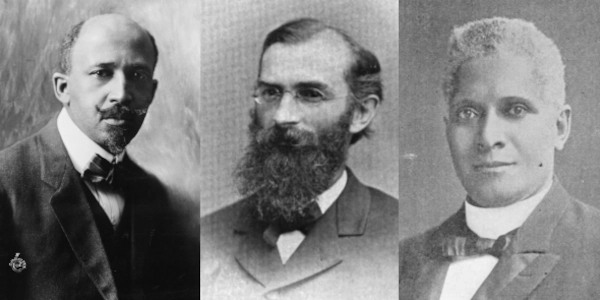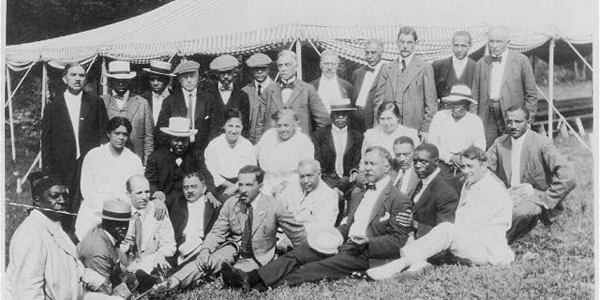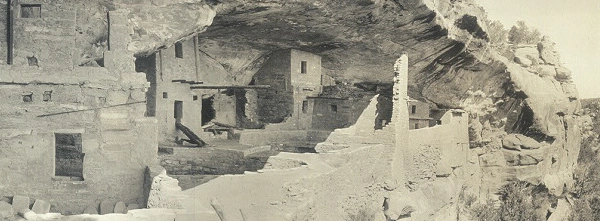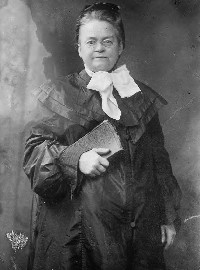
Photo above: Wright Brothers airplane 1903. Right: Mesa Verde Cliff Dwelling. Photos courtesy Library of Congress.
Sponsor this page for $75 per year. Your banner or text ad can fill the space above.
Click here to Sponsor the page and how to reserve your ad.
-
Timeline
1909 Detail
May 31, 1909 - The National Conference of the Negro is conducted, leading to the formation of the National Association for the Advancement of Colored People, (NAACP).

Although slavery had been banned with President Lincoln's preliminary proclamation after the Battle of Antietam and the formal date of the enactment of the Emancipation Proclamation on January 1, 1863, progress in civil rights had not been occuring in a smooth line or at a fast enough pace. While the Reconstruction amendments to the U.S. Constitution had established basic rights of citizenship, voting, and other measures, many tenants of Civil Rights legislation, particularly the Civil Rights Act of 1875, had either been partially overturned, or perhaps even worse, ignored. By the turn of the century, it was apparent that the Southern states had reverted to many of the practices, i.e. Jim Crow, pushing Civil Rights backward in the goal of integration. With the outrage caused by the Springfield race riots on August 14 to 16, 1908 adding to the concern, it was time to take concerted action.
On May 31, 1909 and June 1, 1909, seventy-four leaders in the black community, including W.E.B. DuBois, and civil rights activists in the white community, gathered for the National Conference of the Negro in New York City at the Henry Street Settlement House. It had started out as a committee of twenty black and white civil rights advocates from the city itself on February 12, 1909, the date of the Lincoln Centennial, but had grown in number to include leaders from outside New York. The leaders at the conference saw neglect in many quarters of the civil liberties of the black population, both political and civil, and the need for an organization that could coordinate the already established, but disparate, organizations around the nation. There had been an attempt to involve Booker T. Washington, the foremost black leader of the day, in the conference, but Washington chose not to attend.
The focus was not only on the neglect of civil rights, but also on the advancement of the black population, how it dispelled former beliefs, and enumerated its contributions to society and the economy of the United States.
By the end of the two day meeting, a National Negro Committee of forty was formed. It would announce a second meeting for May 1910 when a permanent organization was organized, the National Association for the Advancement of Colored People. The NAACP was incorporated in 1911, but uses the date of February 12, 1909, the first main meeting of the organizers of the National Negro Conference, as its founding date.
Founders of the NAACP include W.E.B. Du Bois, Ida B. Wells, Archibald Grimké, Mary Church Terrell, Henry Moskowitz, Mary White Ovington, William English Walling, Florence Kelley, Oswald Garrison Villard, and Charles Edward Russell.
Select Quotations from Speeches at the Conference
"... So far tremendous effort in the South has been put forth to keep down economic competition between the races by confining the Negroes by law and custom to certain vocations. But, for two reasons, this effort is bound to break down: First there is no caste of ability corresponding with the caste of color, and secondly because if every Negro in the South worked twenty-four hours a day at the kinds of work which are tacitly assigned him, he could not fill the demand for that kind of
labor. Economic competition is therefore inevitable as facts like these show: In Alabama there are 94,000 Negro farm laborers and 82,000 whites. In Georgia there are 1,100 Negro barbers and 275 white barbers. In Florida there are 2,100 Negroes employed on railroads and 1,500 whites. In Tennessee there are 1,000 white masons and 1,200 black masons. And so on we might go through endless figures showing that economic competition among whites and blacks was not only existent but growing...
... The voteless Negro is a provocation, an invitation to oppression, a plaything for mobs and a bonanza for demagogues. They serve always to distract attention from real issues and to ride fools and rascals into political power. The political campaign in Georgia before the last was avowedly and openly a campaign not against Negro crime and ignorance but against Negro intelligence and property owning and industrial competition as shown by an 83% increase in their property in ten years. It swept the state and if it had not culminated in riot and bloodshed and thus scared capital it would still be triumphant. As it is the end is not yet. The political power of a mass of active working people thus without votes is greater for harm, manipulation and riot than the power of the same people with votes could possibly be, with the additional
fact that voters would learn to vote intelligently by voting. Fourteen years ago Mississippi began disfranchising Negroes. You were promised that the result would be to settle the Negro problem. Is it settled? No, and it never will be until you give black men the power to be men, until you give them the power to defend that manhood. When the Negro casts a free and intelligent vote in the South then and not until then will the Negro problem be settled," W.E.B. DuBois, Professor of Economics and History, Atlanta University.
"... Such was the prophecy of the leading ethnologist whose science taught and still teaches a large section of our people. He declared that the Negro could never be fit to live on equal terms with the white, to be anything more than a slave, because nature had given him nine less cubic inches of brain than she had given us of the Germanic stock. Now consider how this gloomy prophecy with all its science has been exploded. The Negro freedman has proven that he is willing to work, and
that he is capable of thrift. He has supported himself and his dependent children and invalids. He has been the chief agricultural producer in the southern states, and in twenty years had doubled the cotton crops, and nearly quadrupled other farm products. By the last census 34% of the white people of Massachusetts owned their homes, but 37% of the Negroes of Virginia owned theirs.
Negroes own more than 177,000 farms in the country, and operate 581,000 more, a total of 38,250,000 acres. In Mississippi and Louisiana there are more Negro farm owners than white. Thus a large part of the agricultural South is coming into the possession of Negroes. As to pauperism there are over a third more white paupers per thousand than Negro. And meanwhile the less than four million Negroes when Dr. Nott was writing have increased to about ten million. That does not look like
extermination ...," William Hayes Ward, clergyman and editor of the Independent.
"... To realize the full weight of this argument recall to mind a character like John Brown and contrast his attitude with the attitude of to-day. John Brown loved his neighbor as himself. He could not endure, therefore, to see his neighbor poor, unfortunate or oppressed. This natural sympathy was strengthened by a saturation in Hebrew religion which stressed the personal responsibility of every man's soul to a just God. To this religion of equality and sympathy with misfortune, was added the strong influence of the social doctrines of the French Revolution with its emphasis on freedom and power in political life. And on all this was built John Brown's own inchoate but growing belief in a juster and more equal distribution of property. From all this John Brown concluded and acted on that conclusion that all men were created free and equal and that the cost of liberty was less than the price of repression," W.E.B. DuBois, Professor of Economics and History, Atlanta University.

Check out Chronology, A Collection of 50 Short Essays Within the Timeline of American History.
Conference Resolutions
"We denounce the ever-growing oppression of our 10,000,000 colored fellow citizens as the greatest menace that threatens the country. Often plundered of their just share of the public funds, robbed of nearly all part in the government, segregated by common carriers, some murdered with impunity, and all treated with open contempt by officials, they are held in some States in practical slavery to the white community. The systematic persecution of law-abiding citizens and their disfranchisement on account of their race alone is a crime that will
ultimately drag down to an infamous end any nation that allows it to be practised, and it bears most heavily on those poor white farmers and laborers whose economic position is most similar to that of the persecuted race."
"The nearest hope lies in the immediate and patiently continued enlightenment of the people who have been inveigled into a campaign of oppression. The spoils of persecution should not go to enrich any class or classes of the population. Indeed persecution of organized workers, peonage, enslavement of prisoners, and even disfranchisement already threaten large bodies of whites in many Southern States."
"We agree fully with the prevailing opinion that the transformation of the unskilled colored laborers in industry and agriculture into skilled workers is of vital importance to that race and to the nation, but we demand for the Negroes, as for all others, a free and complete education, whether by city State, or nation, a grammar school and industrial training for all. and technical, professional, and academic education for the most gifted.
But the public schools assigned to the Negro of whatever kind or grade will never receive a fair and equal treatment until he is given equal treatment in the Legislature and before the law. Nor will the practically educated Negro, no matter how valuable to the community he may prove, be given a fair return for his labor or encouraged to put forth his best efforts or given the chance to develop that efficiency that comes only outside the school until he is respected in his legal rights as a man and a citizen."
"We regard with grave concern the attempt manifest South and North to deny to black men the right to work and to enforce this demand by violence and bloodshed. Such a question is too fundamental and clear even to be submitted to arbitration. The late strike in Georgia is not simply a demand that Negroes be displaced, but that proven and efficient men be made to surrender their long followed means of livelihood to white competitors.
"As first and immediate steps toward remedying these national wrongs, so full of peril for the whites as well as the blacks of all sections, we demand of Congress and the Executive:
(i.) That the Constitution he strictly enforced and the civil rights guaranteed under the Fourteenth Amendment he secured impartially to all.
(2.) That there he equal educational opportunities for all and in all the States, and that public school expenditure be the same for the Negro and white child.
(3.) That in accordance with the Fifteenth Amendment the right of the Negro to the ballot on the same terms as other citizens be recognized in every part of the country."
"We deplore any recognition of, or concession to, prejudice or color by the federal government in any officer or branch thereof, as well as the presidential declaration on the appointment of colored men to office in the South, contradicting as it does the President's just and admirable utterance against the proposed disfranchisement of the colored voters in Maryland."
Photo above: Montage of three participants in the National Negro Conference of 1909, (left) W.E.B. Dubois, 1918, Cornelius Marion Battey; (center) William Hayes Ward, 1924, The National Cyclopaedia of American Biography, Volume VIII; (right) Bishop Alexander Walters, 1917, the Crises. All photos courtesy Wikipedia Commons. Below: NAACP group photo at Amenia, New York Conference of 1916, 1916, NAACP. Courtesy Library of Congress. Source: Proceedings of the National Negro Conference 1909; Library of Congress; Wikipedia Commons.







